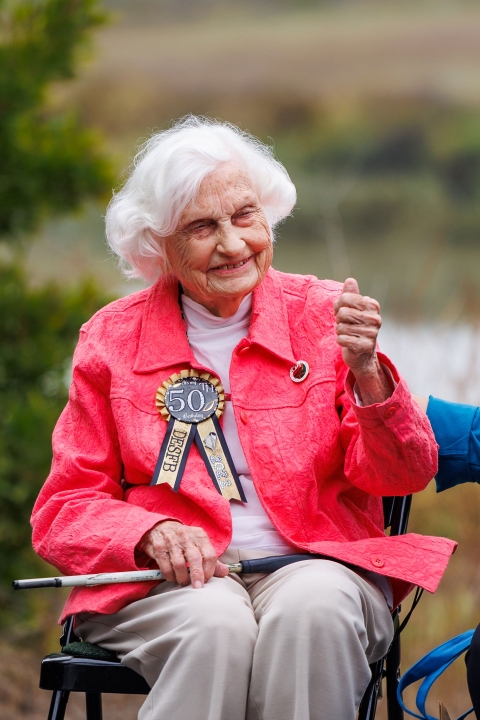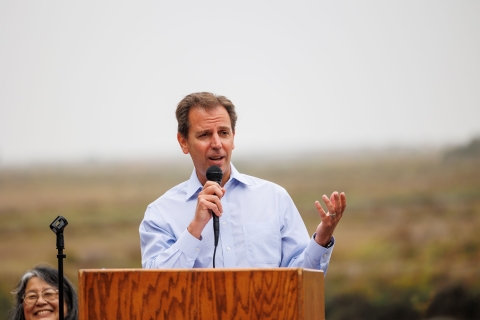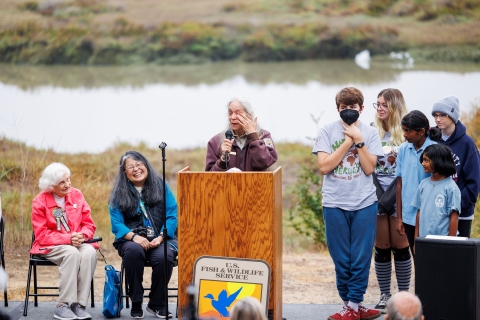On a misty October morning, visitors and old friends gathered among the wetlands of San Francisco Bay to mark a conservation triumph. Fifty years ago, Congress authorized what is now the Don Edwards San Francisco Bay National Wildlife Refuge, protecting thousands of acres of public lands.
The refuge now spans over 30,000 acres and provides crucial habitat for resident species like the endangered California clapper rail and salt marsh salt marsh
Salt marshes are found in tidal areas near the coast, where freshwater mixes with saltwater.
Learn more about salt marsh harvest mouse. Miles of ambling trails welcome over 800,000 visitors every year. But it wasn’t always this serene: activists and conservationists spent decades fighting to protect these wetlands nestled in the heart of Silicon Valley.
Since the 1960s Florence LaRiviere has been leading the charge. Now 98 years old, Florence stood before the group that October morning and said, “Isn’t it wonderful to have something to celebrate, when there’s so much to weep over these days?”
An exercise in patience
LaRiviere’s first experience with the refuge came in 1965, when she responded to an invitation in the local paper: “If you’re worried about what’s happening to the shores of the San Francisco Bay, come to my office.”
She met a group of concerned neighbors in the office of Santa Clara County planner Art Ogilvie, and soon formed a committee aimed at establishing a national wildlife refuge national wildlife refuge
A national wildlife refuge is typically a contiguous area of land and water managed by the U.S. Fish and Wildlife Service for the conservation and, where appropriate, restoration of fish, wildlife and plant resources and their habitats for the benefit of present and future generations of Americans.
Learn more about national wildlife refuge in the San Francisco Bay. The group met with countless community organizations, “Anywhere anyone would have us,” LaRiviere said.
Knowing it would take an act of Congress to establish the refuge, the committee identified Congressman Don Edwards as their champion. In 1972, President Nixon signed Edwards’ bill, establishing the San Francisco Bay National Wildlife Refuge. In 1995, President Clinton renamed it the Don Edwards San Francisco Bay refuge in honor of Congressman Edwards’ dedication to the region.
With the wetlands sprawling behind her, LaRiviere urged the gathering to keep fighting. As climate change climate change
Climate change includes both global warming driven by human-induced emissions of greenhouse gases and the resulting large-scale shifts in weather patterns. Though there have been previous periods of climatic change, since the mid-20th century humans have had an unprecedented impact on Earth's climate system and caused change on a global scale.
Learn more about climate change intensifies, wetlands will play a critical role in supporting wildlife and our communities.
“Don’t anyone forget that the battle is waging on,” LaRiviere said. “I don’t care how many defeats you have; you have to come back and keep at it. Because you will be rewarded.”
Inspiring the next generation
Children ambled among the crowd gathered to celebrate the refuge. The ceremony opened with stories and songs of the Ohlone people, led by Desiree Munoz of the Costanoan Rumsen Carmel Tribe. As Paul Souza, the U.S. Fish and Wildlife Service Regional Director for the Pacific Southwest took the stage, he described the importance of urban refuges. Because of the proximity to millions of residents, urban refuges serve as an important connection between people and wildlife.
“Having an urban refuge like this, bringing people in and giving them a chance to see it firsthand - what we’re doing is creating the next generation of conservation leaders,” Souza said. “Those who will walk in our shoes.”
The San Francisco Bay Area is a place of rich heritage and holds the second-largest metropolitan population west of the Mississippi River. To connect people with the refuge, staff members manage extensive environmental education and community outreach programs.
“Many people will experience the outdoors for the first time in this refuge and get the bug for conservation,” Souza said.
Souza paid homage to the many caretakers of the refuge land. In addition to thanking LaRiviere and partners, he recognized the Ohlone and Miwok people as the original caretakers of the land.
Describing the significant loss of historic wetlands throughout California, Souza reflected on the foresight and wisdom of conservation leaders like LaRiviere who fought to preserve these wetlands.
“We’re standing on the shoulders of giants,” he said.
Making a difference
As the 50th anniversary wound down, Tia Glagolev told the group that LaRiviere inspired her when she was growing up. Tia was a high school student when the refuge was established in 1972. In a biology class, someone told her that one person could make a difference. “I thought, yeah right, forget it,” Glagolev said. “And I believed that until I met Florence.”
Glagolev now serves as a U.S. Fish and Wildlife Service Environmental Educator at the refuge and teaches young people about conservation. Several children joined her on stage as she brushed away tears, recounting the work that they’ve accomplished and their bright futures as budding conservationists.
“That’s the future,” she said.
Click here to view event photos.






